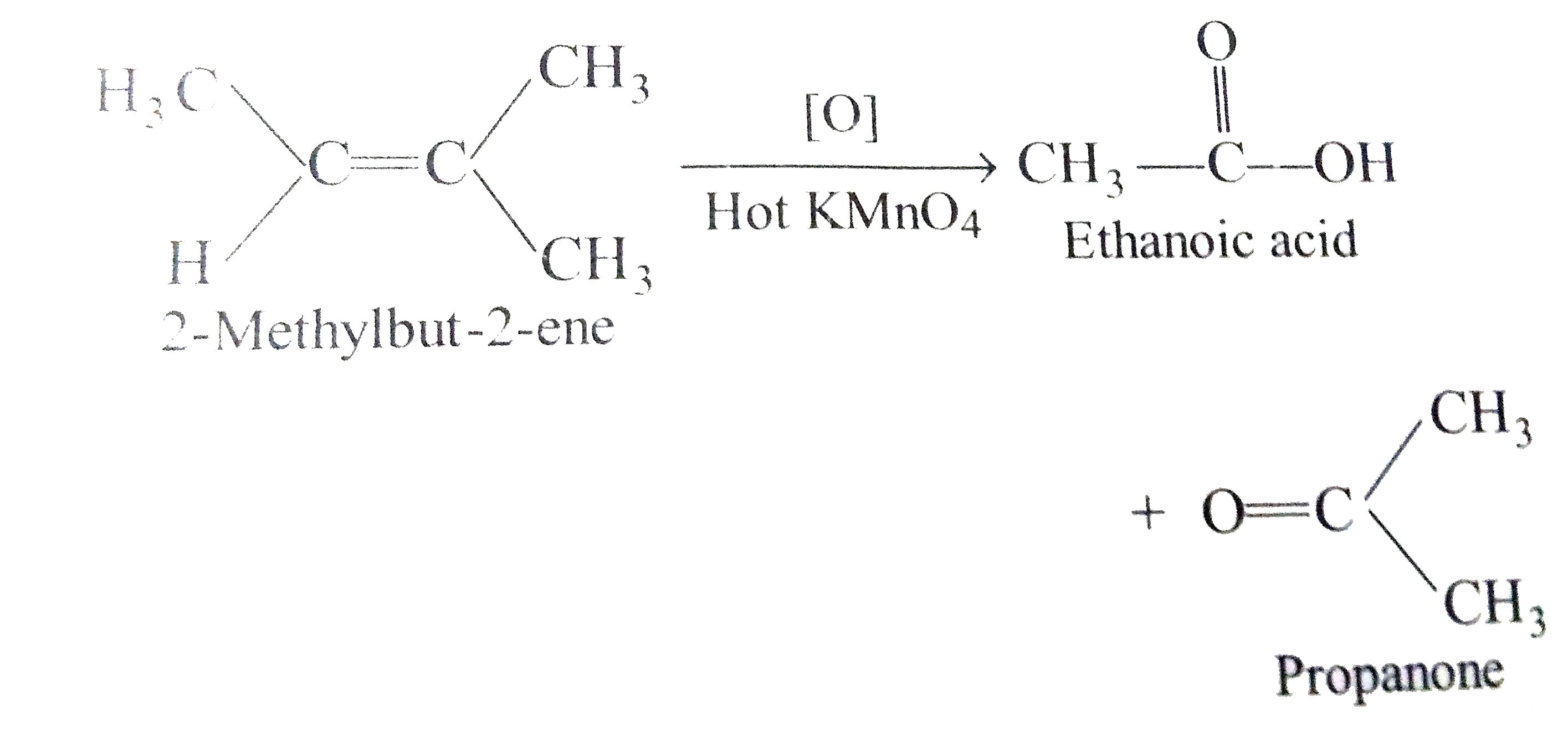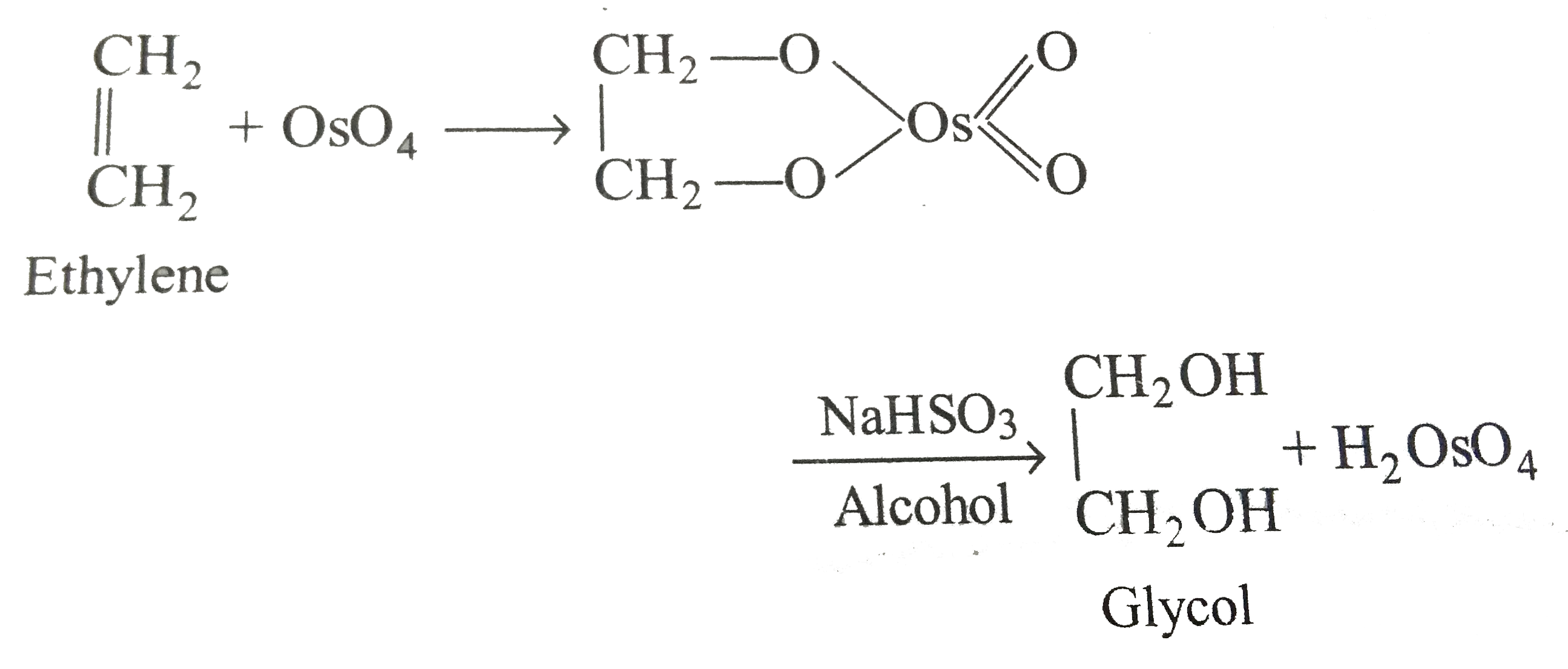Cyclohexene on oxidation with conc. KMnO4 forms
HOOC−(CH2)4−COOH
HOOC−(CH2)3−COOH
HOOC−(CH2)3−O∣∣C−CH3
HOOC−(CH2)4−CH3
The correct Answer is:A
To solve the question regarding the oxidation of cyclohexene with concentrated KMnO₄, we will follow these steps:
1. Identify the Structure of Cyclohexene:
Cyclohexene is a six-membered carbon ring with one double bond. Its molecular formula is C₆H₁₃.
2. Understand the Reaction with KMnO₄:
Concentrated KMnO₄ is a strong oxidizing agent. When alkenes are oxidized with KMnO₄, they typically undergo oxidative cleavage.
3. Oxidative Cleavage of the Double Bond:
In the case of cyclohexene, the double bond between two carbon atoms will be cleaved. Each carbon atom involved in the double bond will be oxidized.
4. Determine the Products:
- When the double bond is cleaved, the carbon atoms that had the double bond will form carboxylic acids if they have hydrogen atoms attached to them.
- In cyclohexene, both carbons involved in the double bond have hydrogen atoms. Therefore, both will be converted to carboxylic acids.
5. Write the Chemical Equation:
The oxidation of cyclohexene with concentrated KMnO₄ leads to the formation of hexanedioic acid (also known as adipic acid). The reaction can be summarized as:
Cyclohexene+KMnO4→Hexanedioic acid
6. Final Product:
The final product of the reaction is hexanedioic acid (C₆H₁₀O₄), which is a dicarboxylic acid.
Conclusion:
Cyclohexene on oxidation with concentrated KMnO₄ forms hexanedioic acid.
---
Cyclohexene is a six-membered carbon ring with one double bond. Its molecular formula is C₆H₁₃.
Concentrated KMnO₄ is a strong oxidizing agent. When alkenes are oxidized with KMnO₄, they typically undergo oxidative cleavage.
In the case of cyclohexene, the double bond between two carbon atoms will be cleaved. Each carbon atom involved in the double bond will be oxidized.
- When the double bond is cleaved, the carbon atoms that had the double bond will form carboxylic acids if they have hydrogen atoms attached to them.
- In cyclohexene, both carbons involved in the double bond have hydrogen atoms. Therefore, both will be converted to carboxylic acids.
The oxidation of cyclohexene with concentrated KMnO₄ leads to the formation of hexanedioic acid (also known as adipic acid). The reaction can be summarized as:
Cyclohexene+KMnO4→Hexanedioic acid
The final product of the reaction is hexanedioic acid (C₆H₁₀O₄), which is a dicarboxylic acid.
Cyclohexene on oxidation with concentrated KMnO₄ forms hexanedioic acid.
Topper's Solved these Questions
- CARBOXYLIC ACID DERIVATIVESBook:BANSALChapter:CARBOXYLIC ACID DERIVATIVESExercise:Exercise 1
Explore 36 Videos
- CARBOXYLIC ACID DERIVATIVESBook:BANSALChapter:CARBOXYLIC ACID DERIVATIVESExercise:Exercise 2
Explore 39 Videos
- ALCOHOL, ETHERS & PHENOL, OXIDATION & REDUCTION Book:BANSALChapter:ALCOHOL, ETHERS & PHENOL, OXIDATION & REDUCTION Exercise:Exercise 3
Explore 28 Videos
- D AND F BLOCK ELEMENTSBook:BANSALChapter:D AND F BLOCK ELEMENTSExercise:EXERCISE-4 (SECTION-B)
Explore 7 Videos
Similar Questions
Knowledge Check
Oxidation of alkenes by cleavage with the acidic or alkaline KmNO4 of acidic K2Cr2O7 at higher temperature yields products depending upon the nature of alkene. A hot solultion of KMnO4 is a strong oxidising agent which gives only ketones and carboxylic acids and not aldehydes (as they cannot be isolated).

Oxidation of alkenes with OsO4 followed by alcoholic NaHSO3 or Na2SO3 yeilds glycols.

Answer the following questions:
An alkene 1-methyl cyclohexene on oxidation with hot basic KMnO4 gives:Aheptanoic acidB2-methylhexanoic acidC6-ketoheptanoic acidDbutanoic acid and acetoneCyclohexene on raction with cold dilute KMnO4 solutioon gives
A(±)−trans−1,2-cyclohexanediolB1,2−cyclohexanediolCcis−1,2−cyclohexanediolDtrans-1,2-cyclohexanediolToluene, on oxidation with KMnO4 gives
AbenzaldehydeBphenolCnitrotolueneDbenzoic acid
Xylenes on oxidation with acidic KMnO4 gives
View SolutionCyclohexanol is dehydrated to cyclohexene on heating with conc. H2SO4. If the yield of this reaction is 75% how cyclohexene will be obtained from 100 g of cyclohexanol ?
View Solutionn−Butylbenzene on oxidation with hot alkanine KMnO4 gives:
View SolutionO- Xylene on oxidation with alkaline KMnO4 followed by acidification with HCl gives
View SolutionWhich alkene on oxidation with acidic KMnO4 gives only acetic acid?
View Solution
